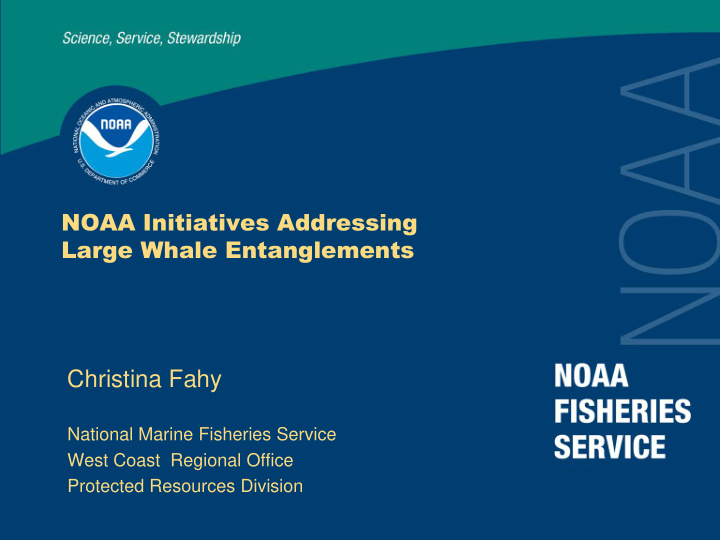



NOAA Initiatives Addressing Large Whale Entanglements Christina Fahy National Marine Fisheries Service West Coast Regional Office Protected Resources Division
NMFS Mandates Marine Mammal Protection Act – reduce marine mammal serious injuries/mortalities in commercial fisheries to insignificant levels Endangered Species Act – recover endangered and threatened species All large whales are protected under the MMPA and most are listed under the ESA 2
3
Challenges Reports are minimum estimates • Estimates that 3.9-13% of gray whales that die (natural/human-caused) in a given year end up stranding and being reported (Punt and Wade 2012) • Low to no observer coverage in pot/trap • Reports of entangled whales never sighted again • Conditions, rugged coastline, low human population in areas, etc. • Gear is often not identified (“crab pot gear”) • Reports may not reflect area of interaction 4
West Coast Priorities for Addressing Large Whale Entanglements • Characterize fixed gear f isheries (“Gear Guide”) • Description • Configuration • Geographic range of effort • Season/management structure • Assess risk of fixed gear fisheries and large whales (humpback, fin, blue, sperm and gray whales) individually and at the stock-level • Improve reporting, response, outreach and education 5
Implement priority activities of large whale Recovery Plans Priority 2 - An action that must be taken to prevent a significant decline in population numbers or habitat quality, or to prevent other significant negative trends short of extinction. Reducing fishery interactions – all Priority 2 in RPs 6
Fixed Gear Guide – CA/OR/WA http://www.westcoast.fisheries.noaa.gov/publications/protected_species/ marine_mammals/fixed_gear_guide_final_12.14.11.pdf 7
Risk Assessment Publication Sept 2013 “Understanding the co -occurrence of large whales and commercial fixed gear fisheries off the west coast of the United States” NOAA -TM-NMFS-SWR-044; Saez et al. 2013 http://www.westcoast.fisheries.noaa.gov/protected_species/ marine_mammals/fisheries_interactions_assess_risk.html 8
9
Outreach/Education 10
Whale Entanglement Fact Sheet 11
Training/Supplies Whale disentanglement training/supplies -annual, west-coast wide -Level I-IV disentanglement specialists - telemetry buoys/tags, etc Whale entanglement reporting DVD (national) 12
2013 Large Whale Entanglement Workshop Goals (Portland, OR) Bring together experts in the fields of marine mammals, fisheries, modeling, bycatch, lost gear/marine debris, and management, to share information relevant to this issue; Continue to identify data gaps, data needs, and next steps; and If possible, begin to develop research and outreach priorities. 13
Priorities Identified Improve outreach and education, particularly to the fishing industry Continue gear research to understand mechanisms of large whale entanglements, and investigate the creation of a gear density-based fishery model. Further investigate elevated risk areas and associated time periods identified by models 14
Questions for the DCTF EC Would the fleet be receptive to small outreach meetings to share information on: Whale entanglement issue and importance Reporting marine mammal serious injuries/mortalities Outreach materials Disentanglement training/supplies If so, can you suggest venues, timing, any other topics they may be interested in? If not, what are your concerns? Would the fleet be receptive to considering research to reduce entanglements? 15
BACKG BACKGROU ROUND ND SLIDES SLIDES 16
Marine Mammal Protection Act Amended in 1994 to include new program for managing marine mammal bycatch: 1. Stock Assessment Reports 2. Categorization of Fisheries 3. Registration/Monitoring Program 4. Reporting (Observer) Program 5. Take Reduction Plans 17
Stoc Stock k Asses Assessme sment nt Repo Reports rts Developed for all U.S. marine mammal stocks Provide estimates of stock abundance and human caused mortalities and serious injuries (including fishery takes) Provides estimates of the “potential biological level” or “PBR” (i.e. how many animals per year is it safe to “take”?” 18
Status of large whales off U.S. West Coast (2013 draft Stock Assessment Report) – minimum population estimate • Non-listed* • ENP Gray whales: 18,017 • Endangered • Blue whales: 1,551 • Fin whales: 2,598 • Humpback whales: 1,876 • Sperm whales: 751 19
Marine Mammal Protection Act List of Fisheries Annual list of ALL U.S. commercial fisheries Each fishery placed into 1 of 3 categories • based on level of marine mammal take (SI/M) • Categorization determines requirements • • Category I – “frequent” takes Category II – “occasional” takes Category III – “rare or no known takes” 20
U.S. West Coast Fisheries Category I Fisheries (# participants/vessels) CA thresher shark/swordfish drift gillnet fishery (25) Covered under Take Reduction Plan *sperm whales Category II Fisheries CA yellowtail/barracuda and white sea bass drift gillnet (50) *by analogy CA halibut/white sea bass set gillnet (30) *humpback whales 21
U.S West Coast Fixed Gear Fisheries (cont’d) Category II Fisheries CA spot prawn pot (27) *humpback whales Eastern North Pacific gray whales CA, OR, WA Dungeness coastal crab pot (534, 433, 228) *humpback whales Eastern North Pacific gray whales CA/OR/WA sablefish pot (309) *humpback whales 22
U.S. West Coast Fixed Gear Fisheries (cont’d) Category III CA coonstripe shrimp, rock crab, tanner crab pot/trap (305) EN Pacific gray whale CA spiny lobster (225) EN Pacific gray whale OR/CA hagfish pot/trap (54) WA/OR shrimp pot/trap (254) WA Puget Sound Dungeness crab pot/trap (249) 23
Marine Mammal Authorization Program Allows commercial fishers to lawfully "incidentally take" a marine mammal in a commercial fishery Any owner of a commercial vessel or non-vessel gear engaging in a Category I or II fishery must obtain a marine mammal authorization from NMFS in order to lawfully incidentally take a marine mammal in a commercial fishery Report (form ) sent to NMFS within 48 hours following return to port – only serious injuries/mortalities of MM http://www.nmfs.noaa.gov/pr/interactions/mmap/ 24
Take Reduction Plan Process 25
Recommend
More recommend